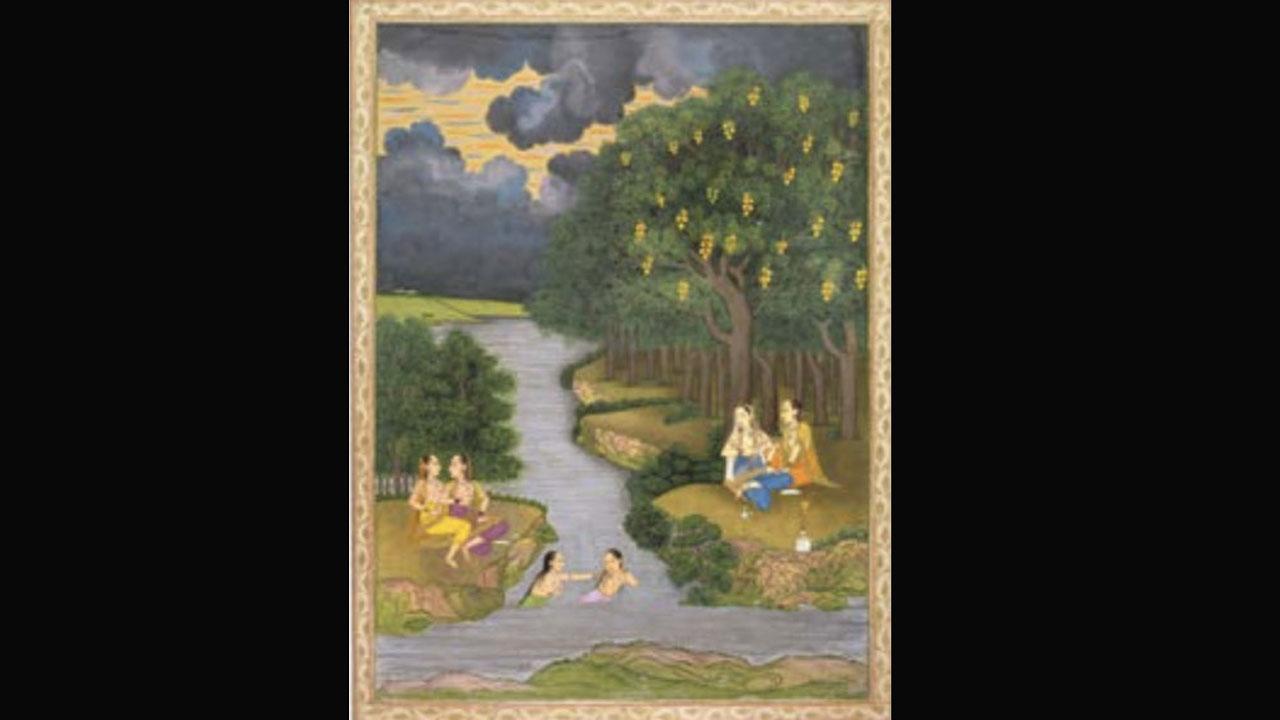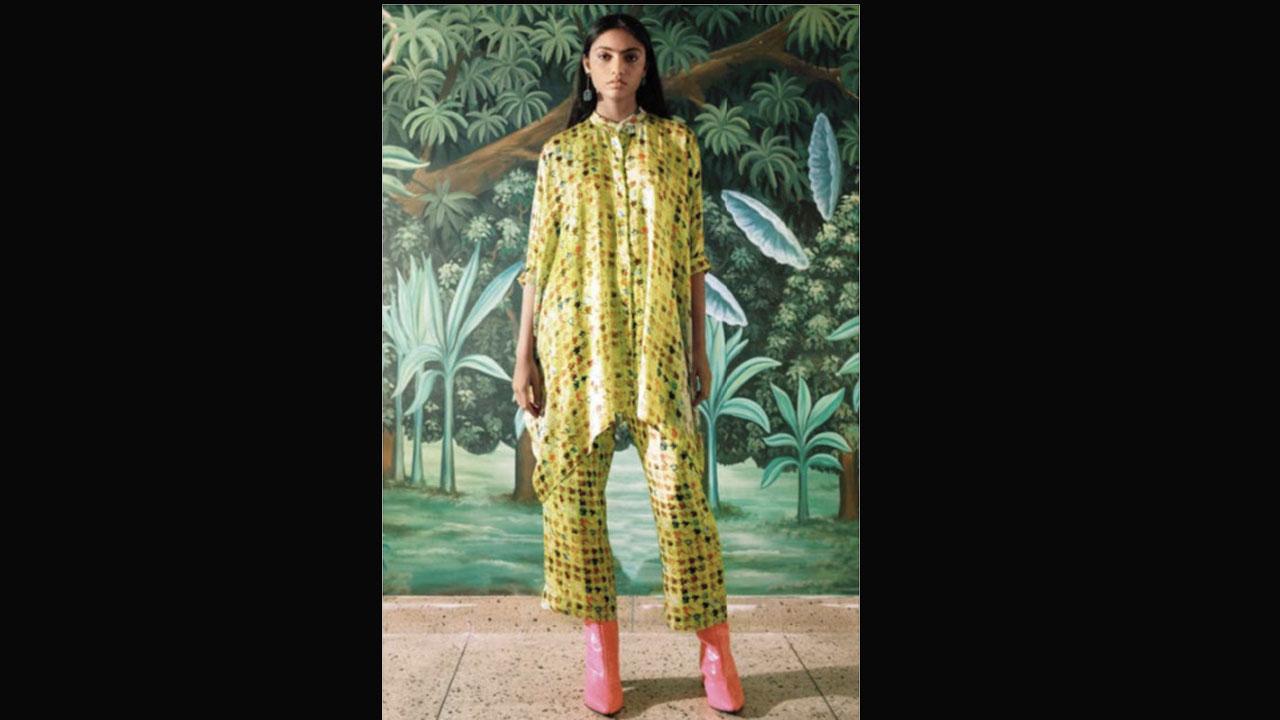It’s that time of the year when the days get longer and the temperatures soar. A renaissance moment ripe for designers to whiplash us with a fresh harvest of maxis and kaftans, swirling paisley and florals, promoted under the exotic hashtag #Indiansummer

A Spring-Summer 2022 look from Salt by Rina Singh’s label, Eka
 Mull over the phrase just a little bit, and there are a few questions that come up when you think, Indian summer. Firstly, we think it states the obvious. Secondly, and more importantly, why should a designer of free India associate a collection with a phrase that some say eludes attempts of political correctness? “You could be forgiven for thinking that it [Indian summer] comes from British colonial rule in India […] One theory goes as far as to credit it to Native Americans ‘American Indians’ […],” according to an article in The Guardian.
Mull over the phrase just a little bit, and there are a few questions that come up when you think, Indian summer. Firstly, we think it states the obvious. Secondly, and more importantly, why should a designer of free India associate a collection with a phrase that some say eludes attempts of political correctness? “You could be forgiven for thinking that it [Indian summer] comes from British colonial rule in India […] One theory goes as far as to credit it to Native Americans ‘American Indians’ […],” according to an article in The Guardian.
ADVERTISEMENT
Perhaps the question of its origin will never be settled. But to use the phrase as marketing rubric is ideologically problematic. In the course of our conversation, designers Rina Singh and Amit Hansraj are univocal about the lasting business appeal of Indian summer looks. The category of relaxed and summery shapes in feel-good fabrics, broadly presented to consumers from March well into July, frees a designer to find more viable points of sales. “The calendar is ideal [for designers] to freshen up clothing racks with two or three drops. The profitable returns are worth the investment,” Singh explains.
 Women enjoying the river at the forest’s edge, c. 1765. Style of Hunhar II (Indian, active mid-1700s), Artokoloro: A miniature painting highlights women playing in the water with their braids untied. Another group sits on the banks of the pond with their drenched silken garments stuck to the hips. As the poem suggests, the Indian summer is experienced by the women along the flora and fauna and a mango tree—dotted with archetypical fruits of the summer
Women enjoying the river at the forest’s edge, c. 1765. Style of Hunhar II (Indian, active mid-1700s), Artokoloro: A miniature painting highlights women playing in the water with their braids untied. Another group sits on the banks of the pond with their drenched silken garments stuck to the hips. As the poem suggests, the Indian summer is experienced by the women along the flora and fauna and a mango tree—dotted with archetypical fruits of the summer
Hansraj’s latest summer line is called, well understandably, An Indian Summer. “Nostalgia does not excite me. I was simply thinking about the way in which the phrase relates to our times,” says Hansraj about his choice of name. During preliminary research, the merchandiser-turned-designer behind the label, Inca, read about the Native American Indian theory. “The idea was to curate a collection that reminded us of India’s heritage of bright-syrupy colours; from bougainvillea pink to hapus yellow,” Hansraj explains. There is no place for washed-out pastels or balmier “phool-patti” motifs in his imagination. Instead, he uses digitally printed houndstooth patterns inspired by the satellite views of his home base, Delhi, while the circle motif denotes life and spirituality. “Every decorative art form, whether Warli, Kantha or Rangoli, either starts or ends in a circle.”
Perhaps, one of the reasons why summer collections rarely move beyond ditsy kairi and flowers and gossamer-fine mulmul is because our idea of summer sits safe, curled up on a fluffy bale of the past. “An ‘Indian summer’ is a colonial concept. In traditional Indian thought and aesthetic, an Indian summer is about ritu,” points out Dr Alka Pande, art historian, curator and author. Grishma (summer) is one of the six ritus or seasons experienced in India, besides Vasant (spring), Varsha (monsoon), Sharad (autumn), Hemant (pre-winter) and Shishir (winter). The poets and writers of Sanskrit literature across centuries, including Kalidasa and Jayadev, have likened Grishma with erotic desire and pangs of separation felt by lovers, Krishna (Nayak) and Radha (Nayika). We wonder why no designer has observed summer through these churns of desire and yearning. “Floral leitmotifs populate Indian miniature paintings; the swirls of the skirt donned by the Nayika could have been a possible source of inspiration for designers,” Dr Pande thinks.
 A design from An Indian Summer by Amit Hansraj’s label, Inca
A design from An Indian Summer by Amit Hansraj’s label, Inca
Here’s how Kalidasa does it. To introduce his readers to the summer and coveting lovers, Kalidasa’s Barahmasa (12 months) spins animated narratives around flora and fauna. “The languid reference to the environment keeps desires at bay, yet not extinguished,” adds Dr Pande. The lotus-like beauty of Krishna, sandalwood paste smeared on his bare torso, the raas-leela performed near the Yamuna River—all paint an al fresco scene in Jayadev’s poem, Geet Govinda. “In the absence of lotus ponds, humming bees and lush gardens, you realise that summer demands we pay a price.
There is a sense of transformation that’s evident because the romance and romanticism around the beauty of nature [associated with spring] is lost.”
 Dr Alka Pande, Amit Hansraj and Rina Singh
Dr Alka Pande, Amit Hansraj and Rina Singh
When a designer interprets summer, perhaps comfortably sketching in an air-conditioned studio, cultural dislocation is bound to set in. “The phrase has turned into a gimmick,” thinks designer Rina Singh of Eka. The brand’s Spring Summer 2022 collection is not arranged by decade or by trend; it’s “more a feeling”. Called Salt, the collection riffs on the wholesome fun of gingham print reminiscent of school pinafores and homestyle kitchen table covers, on one hand.
The other wax preferences for coarse whites embellished in splodges of applique needlework and double-dyed block printing, its carefree, unencumbered drapes subtly spotlighting collarbones and the curves of the hips.
This erogenous play of illusions lends a sense of femininity without looking too girlish.
The storyline and narrative sparks a personal joy and comfort by placing the Indian summer not just in a sartorial context but also as some kind of evolving personality. “By all means, go ahead and look at the halcyon of the Indian summer but not always through rose-tinted glasses of charmed destinations that transport you and hyper-decadence,” argues Singh.
 Subscribe today by clicking the link and stay updated with the latest news!" Click here!
Subscribe today by clicking the link and stay updated with the latest news!" Click here!







